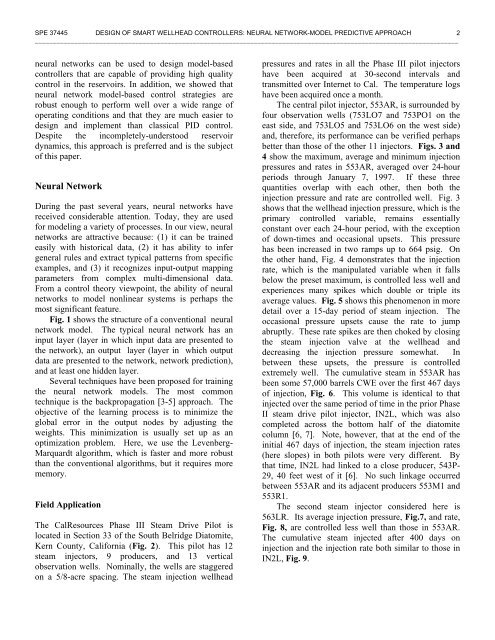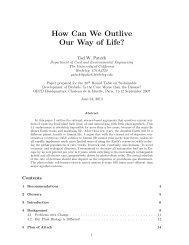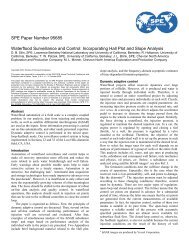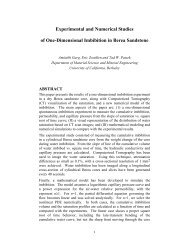SPE 37445 DESIGN OF SMART WELLHEAD CONTROLLERS: NEURAL NETWORK-MODEL PREDICTIVE APPROACH2______________________________________________________________________________________________________________________neural networks can be used to design model-basedcontrollers that are capable <strong>of</strong> providing high qualitycontrol in the reservoirs. In addition, we showed thatneural network model-based control strategies arerobust enough to per<strong>for</strong>m well over a wide range <strong>of</strong>operating conditions and that they are much easier todesign and implement than classical PID control.Despite the incompletely-understood reservoirdynamics, this approach is preferred and is the subject<strong>of</strong> this paper.Neural NetworkDuring the past several years, neural networks havereceived considerable attention. Today, they are used<strong>for</strong> modeling a variety <strong>of</strong> processes. In our view, neuralnetworks are attractive because: (1) it can be trainedeasily with historical data, (2) it has ability to infergeneral rules and extract typical patterns from specificexamples, and (3) it recognizes input-output mappingparameters from complex multi-dimensional data.From a control theory viewpoint, the ability <strong>of</strong> neuralnetworks to model nonlinear systems is perhaps themost significant feature.Fig. 1 shows the structure <strong>of</strong> a conventional neuralnetwork model. The typical neural network has aninput layer (layer in which input data are presented tothe network), an output layer (layer in which outputdata are presented to the network, network prediction),and at least one hidden layer.Several techniques have been proposed <strong>for</strong> trainingthe neural network models. The most commontechnique is the backpropagation [3-5] approach. Theobjective <strong>of</strong> the learning process is to minimize theglobal error in the output nodes by adjusting theweights. This minimization is usually set up as anoptimization problem. Here, we use the Levenberg-Marquardt algorithm, which is faster and more robustthan the conventional algorithms, but it requires morememory.Field ApplicationThe CalResources Phase III Steam Drive Pilot islocated in Section 33 <strong>of</strong> the South Belridge Diatomite,Kern County, Cali<strong>for</strong>nia (Fig. 2). This pilot has 12steam injectors, 9 producers, and 13 verticalobservation wells. Nominally, the wells are staggeredon a 5/8-acre spacing. The steam injection wellheadpressures and rates in all the Phase III pilot injectorshave been acquired at 30-second intervals andtransmitted over Internet to Cal. The temperature logshave been acquired once a month.The central pilot injector, 553AR, is surrounded byfour observation wells (753LO7 and 753PO1 on theeast side, and 753LO5 and 753LO6 on the west side)and, there<strong>for</strong>e, its per<strong>for</strong>mance can be verified perhapsbetter than those <strong>of</strong> the other 11 injectors. Figs. 3 and4 show the maximum, average and minimum injectionpressures and rates in 553AR, averaged over 24-hourperiods through January 7, 1997. If these threequantities overlap with each other, then both theinjection pressure and rate are controlled well. Fig. 3shows that the wellhead injection pressure, which is theprimary controlled variable, remains essentiallyconstant over each 24-hour period, with the exception<strong>of</strong> down-times and occasional upsets. This pressurehas been increased in two ramps up to 664 psig. Onthe other hand, Fig. 4 demonstrates that the injectionrate, which is the manipulated variable when it fallsbelow the preset maximum, is controlled less well andexperiences many spikes which double or triple itsaverage values. Fig. 5 shows this phenomenon in moredetail over a 15-day period <strong>of</strong> steam injection. Theoccasional pressure upsets cause the rate to jumpabruptly. These rate spikes are then choked by closingthe steam injection valve at the wellhead anddecreasing the injection pressure somewhat. Inbetween these upsets, the pressure is controlledextremely well. The cumulative steam in 553AR hasbeen some 57,000 barrels CWE over the first 467 days<strong>of</strong> injection, Fig. 6. This volume is identical to thatinjected over the same period <strong>of</strong> time in the prior PhaseII steam drive pilot injector, IN2L, which was alsocompleted across the bottom half <strong>of</strong> the diatomitecolumn [6, 7]. Note, however, that at the end <strong>of</strong> theinitial 467 days <strong>of</strong> injection, the steam injection rates(here slopes) in both pilots were very different. Bythat time, IN2L had linked to a close producer, 543P-29, 40 feet west <strong>of</strong> it [6]. No such linkage occurredbetween 553AR and its adjacent producers 553M1 and553R1.The second steam injector considered here is563LR. Its average injection pressure, Fig.7, and rate,Fig. 8, are controlled less well than those in 553AR.The cumulative steam injected after 400 days oninjection and the injection rate both similar to those inIN2L, Fig. 9.
SPE 37445 DESIGN OF SMART WELLHEAD CONTROLLERS: NEURAL NETWORK-MODEL PREDICTIVE APPROACH3______________________________________________________________________________________________________________________The temperature response to steam injection in553AR is shown in Figs. 10-11 to the west <strong>of</strong> thehydr<strong>of</strong>racture planes, and in Figs. 12-13 to the east <strong>of</strong>them. The two east observation wells (PO-1 and LO-7) are almost vertical across the diatomite column, andare nominally 25 feet E-SE from the upperhydr<strong>of</strong>racture plane, and 40 feet E-SE from the lowerone. The west observation wells are also vertical andare nominally 10 ft (LO-5) and 25 feet (LO-6) W-NWfrom the upper hydr<strong>of</strong>racture plane, and 30 feet and 15feet W-NW from the lower hydr<strong>of</strong>racture plane,respectively. If the conductive heating from a slowlymoving heat front dominates, and the hydraulicdiffusivities are equal on both sides <strong>of</strong> thehydr<strong>of</strong>ractures in 553AR, then one expects theobservation wells to respond in proportion to theeast/west injection distance / time . There<strong>for</strong>e,one expects LO-7, PO-1 and LO-6 to respond similarlyacross the upper injection interval. They do not. Forexample, about six times more heat goes towards LO-6than LO-7. If one then compares PO-1 after 569 dayswith in LO-6 after 100 days, then somewhat more heatis flowing towards PO-1 than LO-6. A similarcomparison <strong>of</strong> LO-7 and LO-6 reveals the samebehavior. Hence, from Figs. 10-13 it follows that thesquare-root-<strong>of</strong>-time scaling is approximately correct<strong>for</strong> the lower hydr<strong>of</strong>racture, but the upper one requiresa more sophisticated analysis, such as the one in Refs.[6, 7].The first discernible heating to the east <strong>of</strong> 553ARoccurs after 100 days <strong>of</strong> steam injection. Then, theheating progresses in proportion to the square root <strong>of</strong>time until 200-300 days on injection. Later, the rate <strong>of</strong>heating slows down visibly, probably due to arearrangement <strong>of</strong> steam injection westward. To thewest <strong>of</strong> the hydr<strong>of</strong>racture planes in 553AR, theresponse in LO-7 is mostly through conductive heatingand mostly at the boundary <strong>of</strong> the L and K cycles.This response accelerates, however, in the M-cycleafter 300 days on injection. A strong temperatureresponse is also evident in PO-1 in the M-cycle.Un<strong>for</strong>tunately, in this well, the temperature logsextended to the M-cycle only after 500 days oninjection.Model Identification <strong>for</strong> the CalResourcesSteam InjectorsHistorical data from two steam injectors in thePhase III pilot have been used to develop their neuralnetwork (NN) models. The inputs to each model areflow rates and wellhead pressures in 30-secondintervals.The NN model has ten input nodes, three hiddennodes (with a nonlinear transfer function), and oneoutput node (with a nonlinear transfer function). Theinputs include 1 current value and 4 previous values <strong>of</strong>the injection pressure and flow rate <strong>for</strong> a given well.The output is a prediction <strong>of</strong> the injection flow rate onetime interval into the future. The input and output dataare scaled uni<strong>for</strong>mly between 0 and 1. Figs. 14 and 15show excellent per<strong>for</strong>mance <strong>of</strong> the network models.In addition, we developed a NN model <strong>for</strong>prediction <strong>of</strong> the injection pressure. The NN model hasten input nodes, five hidden nodes (with a nonlineartransfer function), and one output node (with anonlinear transfer function). The inputs include 1current value and 4 previous values <strong>of</strong> the injectionpressure and flow rate <strong>for</strong> a given well. The output is aprediction <strong>of</strong> the injection pressure one time intervalinto the future. The input and output data are scaleduni<strong>for</strong>mly between 0 and 1. Figs. 16 and 17 showexcellent per<strong>for</strong>mance <strong>of</strong> the network models.To predict the outputs more than one time step intothe future, iteration through the neural network isrequired. Fig. 18 shows that the per<strong>for</strong>mance <strong>of</strong> thenetwork is seriously affected by iteration. However,this model is effective and has good per<strong>for</strong>mance <strong>for</strong>up to 20 steps into the future (Fig. 19). Hence, thismodel can be used without any further modification <strong>for</strong>Neuro-Geometric control [1] or Dynamic NeuralNetwork control (DNNC) [9, 10], since in this case weonly need one-step prediction. For model-basedstrategies with more than one step, usually we needless than 10 iterations. There<strong>for</strong>e, <strong>for</strong> Long-Prediction-Horizon Model Predictive control purposes, this modelshould also be sufficient.To study different scenarios <strong>of</strong> injection policieshowever, we need more iterations. Un<strong>for</strong>tunately,conventional neural networks are not stable once theyare subjected to long-term prediction through iteration.In this study, an alternative model proposed in Ref. [9,10] is used. In this model, part <strong>of</strong> the in<strong>for</strong>mation fromthe input layer is presented into the output layer. Theeffect <strong>of</strong> this additional connection is to filter theprediction from the hidden layer. This prevents noisefrom propagating further into the network predictions.Figs. 20 and 21 show the structure and per<strong>for</strong>mance <strong>of</strong>the new network model. However, further study isneeded to better understand the properties <strong>of</strong> this new









